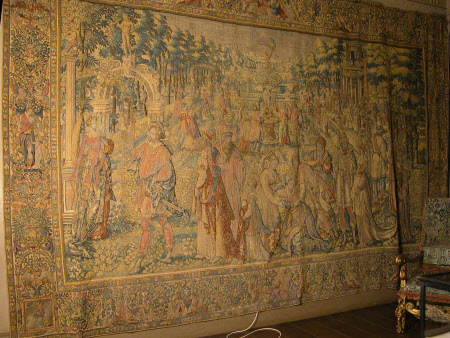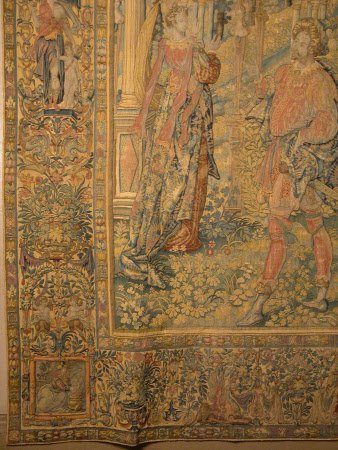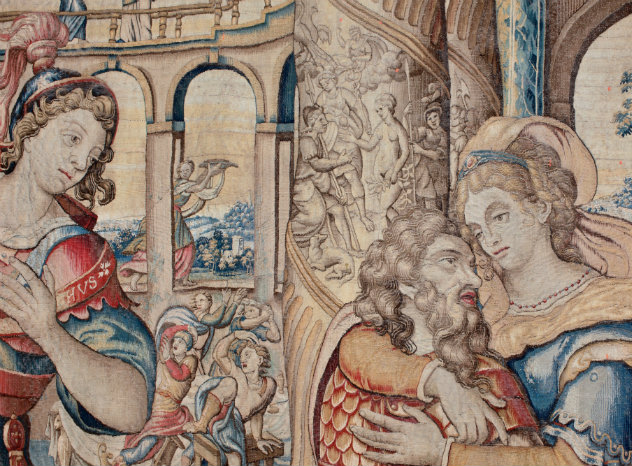Oriane Passing the Magical Love Tests
François Spiering (c. 1551-1631)
Category
Tapestries
Date
circa 1590 - circa 1610
Materials
Tapestry, wool and silk, 8 warps per cm
Measurements
3.37 x 5.25 m
Place of origin
Delft
Order this imageCollection
Knole, Kent
NT 128792
Caption
The three tapestries in the Venetian Ambassadors’ Room at Knole are among the most important in the National Trust’s collection. They are rare survivals of the work of François Spiering, a master weaver who emigrated from Antwerp to the newly-founded Dutch Republic at the end of the sixteenth century and went on to produce some of the finest tapestries in Europe. The design is attributed to Karel van Mander. They seem to have formed part of a large consignment of tapestries acquired by the 6th Earl of Dorset from Whitehall Palace in 1695, soon after the death of Queen Mary II (1694). They depict scenes from the popular chivalric romance Amadis de Gaule and from the Greek myths. François Spiering’s extraordinarily detailed work, dense thread count and artistry make these the finest tapestries of their type in the National Trust.
Summary
Tapestry, Oriane Passing the Magical Love Tests, from the workshop of François Spiering, Delft, c. 1590-1610. In the foreground richly dressed couples walk through a garden, with a young woman in the centre falling to the ground (struck by an invisible force because she is not beautiful enough to enter the enchanted garden). On the left is an archway with a statue holding a horn above it – the first test to enter the enchanted garden. Beyond there is a formal garden with a hedge-lined walkway leading to a fountain and the statue of Venus in the centre. Venus herself hands the Golden Apple to Oriane. In the background, is a labyrinth with a Colossus, a golden statue holding a burning lamp in the centre. To the left of the garden there is woodland with exotic animals, and to the right Apolidon’s marble palace, towards which pairs of lovers slowly make their way. Adamis and Oriane are seen breaking the spell (cloud of smoke) and entering the magical palace. In the distance there is a landscape with mountains at either side. The tapestry has deep borders decorated with foliage, scrollwork and fantastic creatures including sphinxes. In the upper centre there is a reclining figure of Jupiter carrying a sceptre and a thunderbolt and accompanied by an eagle with a set of scales in its beak, and there are figures of Venus and Cupid in the left border and Minerva on the right. At the centre of the lower border is Juno accompanied by her emblem of a peacock. In the corners are small scenes with allegories of the four seasons. At the upper edge of the lower border the tapestry is signed in latin ‘FRANCISCVS SPIRINGIVS FECIT’.
Full description
‘Oriane Passing the Magical Love Tests’ comes from a larger series of the ‘Story of Amadis de Gaule’. Amadis de Gaule is a medieval chivalric legend of Iberian origin, which existed in oral tradition before it was first written down in 1508 by Rodriguez de Montalvo. The story quickly became very popular and was translated and expanded in many different languages throughout the sixteenth century. The narrative follows the adventures of Amadis, a knight-errant seeking to establish the secret of his parentage and to prove himself worthy of the love of the beautiful Princess Oriana. The story of Amadis fell out of fashion as the age of courtly love came to a close, and the tapestry at Knole was mis-identified for nearly 300 years. It was only in the mid-1990s that the subject of this and related tapestries was identified by the Belgian scholar Anne Desprechins de Gaesebeke (Desprechins de Gaesebeke 1996a, b). The present tapestry shows an episode towards the end of the story, where the lovers Amadis and Oriane are finally united, and a number of other marriages take place. The scene is set on the ‘Isle Ferme’, the former abode of the magician Apolidon, who had cast a spell so that only men as valiant as he and women as beautiful as his wife Grimanèse could gain access to his magnificent palace of love. The tapestry shows a series of courtly couples undergoing magical tests to decide whether they can enter the palace. On the left Amadis and Oriane successfully pass under an enchanted archway, whilst in the centre one of their unfortunate companions, having been deemed not beautiful enough, is thrown to the ground by an invisible force. In the background Amadis and Oriane are seen again by a fountain, with Venus herself offering Oriane the legendry Golden Apple in recognition of her great beauty. Elsewhere in the garden more couples undergo tests of the sincerity of their love before being allowed to approach the palace itself on the right hand side. A further four subjects are known from the ‘Amadis de Gaule’ series: ‘The Liberation of Oriane’ (examples survive in the Metropolitan Museum, New York and the Museo Poldi Pezzoli, Milan); ‘Amadis Bidding Farewell to Oriane’ (Museo Poldi Pezzoli, Milan); ‘The Presentation of the Enchanted Lance’ (private collection, London); and ‘Amadis Duelling with the Knights of Léonorette’ (private collection, Rome) (Campbell 2007, pp. 36-43; Forti-Grazzini in Zanni 2005, pp. 22-31; Standen 1988, pp. 9-11; Franses 2007, pp. 24-28). A second version of ‘Oriane Passing the Magical Love Tests’, now in the collection of Princeton University, includes the initials ‘KVM’ on the shield held by a lion sitting atop a column on the left hand side of the scene (which in the version at Knole is plain blue with a red band). These are the initials of Karel van Mander I (1548-1606), now best known as the author of the ‘Schilder-boek’ (1604 / 1618), the first biography of northern European artists, but also a painter and tapestry designer (Standen 1988, pp. 9-11). Van Mander’s drawing for ‘Amadis Passing the Magical Love Tests’ is ni the State Hermitage Museum, Saint Petersburg (Campbell 2007, pp. 36-43). The tapestry was made by François Spiering, whose signature appears at the upper edge of the lower border. Spiering is first recorded as a tapestry entrepreneur in Antwerp in the 1570s. In 1576, when the town was sacked by Spanish troops who stole many tapestries from the vast ‘Pand’ or dealer’s warehouse in the town, he lost a large amount of stock. As a Mennonite protestant he then fled the Southern Netherlands, which were controlled by the Catholic Habsburgs, and settled in Delft in the newly independent United Provinces of the Northern Netherlands. He set up a tapestry workshop in an abandoned convent given to him by the Delft city authorities in 1592, but may have been working in the town during the 1580s. Spiering produced tapestries that were quite distinct from anything being made in the Southern Netherlands. His tapestries were characterised by the elegant, elongated figures and complex narratives provided by Karel van Mander, an exquisite attention to pattern and surface detail, a fine weave with a high silk content and a subtle colour palette. Spiering’s tapestries soon gained popularity among the Protestant courts of Northern Europe and he worked for the King of Sweden and the authorities of many Northern Netherlandish provinces, but perhaps his greatest success was with the English court. In 1592 he received a commission for a set of tapestries of the ‘Spanish Armada’ from Charles Howard of Effingham, which would be one of the most iconic tapestry sets in England for the next 200 years (See Farrell 2010). He sold ‘Diana’ tapestries to Sir Walter Raleigh in 1593 (probably after the same designs as the two at Knole, nos. 130081.2, 3), and a number of other commissions and gifts are recorded, including a purchase of ‘three pieces of fine tapestry hangings’ from ‘Francois Spierincx, Merchant Stranger’ for King James I in 1607 (CSP Dom 1603-10, p. 371; for details on Spiering’s career see Donnet 1894; Van Ysselsteyn 1936, passim; Campbell 2007, pp. 22-27; Hartkamp-Jonxis 2009, pp. 20-28). ‘Oriane Passing the Magical Love Tests’ is one of three tapestries by Spiering at Knole: the other two come from a set of the ‘Story of Diana' (nos. 130081.2, 3). The three have been treated as a set since the early eighteenth century. Their earlier provenance is unknown, but it is possible that they originate in the English Royal Collection, and there are two potential routes for their arrival at Knole. Lionel Cranfield, 1st Earl of Middlesex (1575-1645), a prominent politician under James I, received perquisites from the Royal Collection in his role as Master of the Wardrobe; his daughter Frances Cranfield married Richard, 5th Earl of Dorset (1622-77) and his collection, much of it kept at Copt Hall in Essex, eventually came to Knole. Charles, 6th Earl of Dorset (1638-1706) also received royal perquisites as Lord Chamberlain in the 1690s, and many of these goods first went to Copt Hall before being brought to Knole, along with the Cranfield chattels, when Copt Hall was sold in 1701. The lists of goods brought from Copt Hall to Knole in 1700-01 include a number of tapestries, but none can definitely be identified as the three Spiering pieces. They may be the ‘Three peices of very fine Tapistry Storys out of Ovid 10. Foot Deep’ in the Wardrobe at Knole in the 1706 inventory (MS kept at Knole). References to the description of ‘Oriane Passing the magical Love Tests’ as a ‘Garden Scene’ in 1705 are incorrect, and based on a misreading of Phillips 1930 (p. 449). The tapestries may have been installed in the Venetian Ambassador’s Room when it was remodelled by William Kent in c. 1730. (Helen Wyld, 2012)
Provenance
Given to the National Trust with the house and part of the contents by Major-General Sir Charles Sackville-West, 4th Lord Sackville (1870 – 1962) in 1946
Credit line
Knole, The Sackville Collection (The National Trust)
Marks and inscriptions
At upper edge of lower border: FRANCISCVS • SPIRINGIVS • FECIT • On stone monument, upper centre: OR… E / L / A / R / H O On palace, right hand side: CA[]A DEFA / DE[]M APO M
Makers and roles
François Spiering (c. 1551-1631), workshop Karel van Mander (Meulebeke 1548 - Amsterdam 1606), designer
References
Donnet, 1894: Fernand Donnet, ‘Les tapisseries de Bruxelles, Enghien et Audenarde pendant la furie Espagnole (1576)’, Annales de la société d’Archéologie de Bruxelles, vol. 8 (1894), pp. 442-476 CSP Dom 1603-1610: Calendar of State Papers, Domestic: James I, 1603-1610, London 1857 Phillips 1930: Charles J Phillips, History of the Sackville Family, Earls and Dukes of Dorset. Together with a description of Knole, early owners of Knole, and a catalogue raisonné of the pictures and drawings at Knole, London 1930 van Ysselsteyn, 1936: G T van Ysselsteyn, Geschiedenis der tapijtweverijen in de noordelijke Nederlanden. Bijdrage tot de geschiedens der kunstnijverheid, 2 vols., Leiden 1936 Erkelens 1962: A M Erkelens, ‘De Wandtapijtkunst te Delft,’ Oud Delft, Vol 1 (1962) Standen 1988: Edith Standen, ‘Some Tapestries at Princeton’, Record of the Art Museum at Princeton University, vol. 47, no. 2 (1988), pp. 8-11 Luijten 1993: Ger Luijten (ed.), The Dawn of the Golden Age: Northern Netherlandish Art 1580-1620, exh. cat. Rijksmuseum, Amsterdam 1993 Desprechins de Gaesebeke 1996a: Anne Desprechins de Gaesebeke, ‘Une Tenture d’Amadis de Gaule tissée à Delft d’après les cartons de Karel van Mander’, Gentse bijdragen tot de kunstgescheidenis en oudheidkunde, 31 (1996), pp. 81-96 Desprechins De Gaesebeke, 1996: Anne Desprechins De Gaesebeke. “A la gloire d’Amadis: tapisseries de Delft d’apres Karel van Mander.” Gazette des Beaux-Arts 128.1535 (1996): pp.253-62. Liedtke 2001: Walter A Liedtke (ed.), Vermeer and the Delft School, exh. cat. Metropolitan Museum of Art, New York 2001 Hartkamp-Jonxis and Smit 2004: Ebeltje Hartkamp-Jonxis and Hillie Smit, European Tapestries in the Rijksmuseum, Amsterdam 2004 Zanni 2005: Annalisa Zanni (ed.), Le imprese tessute di Amadigi di Gaula. Due arazzi del Museo Poldi Pezzoli, Milan 2005 Campbell, 2007a: Thomas Campbell et al., Tapestry in the Baroque: Threads of Splendor, exh. cat. Metropolitan Museum of Art, New York 2007 Franses 2007: Dutch Tapestry in the Golden Age: 1590-1650, exh. cat. Franses, New York 2007 Hartkamp-Jonxis 2009: Ebeltje Hartkamp-Jonxis, Weaving Myths: Ovid’s Metamorphoses and the Diana Tapestries in the Rijksmuseum, Amsterdam 2009 Farrell 2010: Stephen Farrell, ‘The Armada Tapestries in the Old Palace of Westminster’, Parliamentary History, vol. 29, part 3 (2010), pp. 416-440 Fryman and Town 2011: Olivia Fryman and Edward Town, ‘Lionel Cranfield and the Furnishing of Chelsea House 1620-25’, Furniture History Society Newsletter, pp. 1-5



